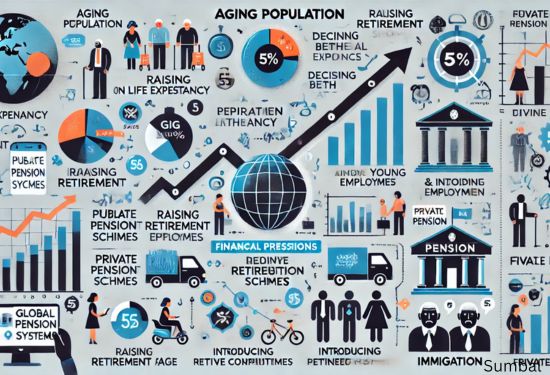The Impact of Demographic Shifts on Global Pension Systems
Pressure on pension systems worldwide is aggressive due to inherent demographic trends such as an aging population, low birth rates, and changing employment relationships. They claimed these changes require certain adjustments to make the pension systems sustainable and able to support future retirees effectively.

Aging Population and Increased Life Expectancy
The average life span continues to rise; therefore, retirees use pension funds for longer durations than in the past. This steady increase in life expectancy presents a significant problem for pension schemes, particularly for those so-called ‘pay as you go systems’ where the present workers are the source of funding for the retiring generation. This scenario extends the pension stock that has to feed more people since more people live longer than before, exposing it to underfunding.
Declining Birth Rates and a Shrinking Workforce
At the same time, many regions are experiencing slower growth rates in the working population because birth rates have fallen. This demographic change decreases the working-age population-to-dependent ratio or puts pressure on working-population-funded pension schemes. The scarcity of young people in Japan and Germany means they currently face problems with financing pensions. They could either raise contributions even higher or cut pensions.
Gig Economy and Informal Employment are Changing the World
Different employment relations, especially the emergence of the gig economy and non-traditional work models, also affect pension systems. While strictly speaking, self-employed individuals refer to those who pursue business on their account without hiring employees, freelancers, and gig workers rarely have access to employer-funded retirement plans. Thus, they have gaps in their experience. Some countries are considering solving the problem with portable retirement accounts enabling gig workers to save for retirement, relying on the portable scheme regardless of employment status.

Financial Pressures on Pension Systems
These demographic shifts add a new financial burden on the pension system. In response, many countries are adopting restructuring policies to promote sustainable development. Adjustments include increasing the retirement age, changing the framework for calculating benefits, and promoting personal savings. Another reform seeking to cut public pension costs is the transition from defined benefit pensions to defined contribution schemes whereby people have to bear the significant risks of retirement financing.
Shift Toward Private and Hybrid Pension Models
Due to rising pressures on the public pension systems, there has been a shift to private and semi-private pension schemes. Some privately funded schemes by individuals or employers provide an effective solution to state-provided pension schemes and cut down the burden of the government’s resources. Such systems that integrate means-tested public pension coupled with a mandatory personal pension are quickly diversified markets for retirement funding hence providing retired persons with tools to counter any adversity.

The Role of Immigration and Technology in Pension Systems
Immigration can, to some extent, solve demographic challenges, as it will help increase the number of people of working age so they can contribute to pension funds. For instance, many developed countries, such as Canada and Australia, encourage immigration to support labor markets and pension systems.
Demographics are also crucial to implementing technology to cope with the changes. They also employ prediction and data mining to predict the value of pension liabilities and make appropriate investment decisions. Another feature of increasing pension systems' flexibility is an offer for choice, which permits adjusting the retirement age and pensions for every individual.
(Writer:Haicy)





